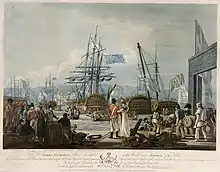HMS Caesar (1793)
HMS Caesar, also Cæsar, was an 80-gun third rate ship of the line of the Royal Navy, launched on 16 November 1793 at Plymouth. She was designed by Sir Edward Hunt, and was the only ship built to her draught.[1] She was also one of only two British-built 80-gun ships of the period, the other being HMS Foudroyant.
_engaging_Mont_Blanc.jpg.webp) HMS Caesar engaging Mont Blanc at the Battle of Cape Ortegal, 4 November 1805 | |
| History | |
|---|---|
| Name | HMS Caesar |
| Ordered | November 1783 |
| Builder | Plymouth Dockyard |
| Laid down | 24 January 1786 |
| Launched | 16 November 1793 |
| Fate | Broken up, 1821 |
| Notes |
|
| General characteristics [1] | |
| Class and type | 80-gun third rate ship of the line |
| Tons burthen | 2002 74⁄94 (bm) |
| Length | 181 ft (55 m) (gundeck) |
| Beam | 51 ft 3 in (15.62 m) |
| Depth of hold | 22 ft 4 in (6.81 m) |
| Propulsion | Sails |
| Sail plan | Full-rigged ship |
| Armament |
|
Service
In 1798, some of her crew were court-martialed for mutiny.[2]
Battle of Algeciras Bay

She was involved in the Battle of Algeciras Bay in 1801, during which her Master, William Grave, was killed[3]

Battle of Cape Ortegal
The Battle of Cape Ortegal was the final action of the Trafalgar Campaign, and was fought between a squadron of the Royal Navy and a remnant of the fleet that had been destroyed several weeks earlier at the Battle of Trafalgar. It took place on 4 November 1805 off Cape Ortegal, in north-west Spain and saw a squadron under Captain Sir Richard Strachan in Caesar defeat and capture a French squadron under Rear-Admiral Pierre Dumanoir le Pelley.
Battle of Les Sables-d'Olonne
In 1809, she took part in the Battle of Les Sables-d'Olonne.
Fate
She was converted to serve as a depot ship in 1814, and was broken up in 1821.[1]
Notes
- Lavery, Ships of the Line, vol. 1, p. 183.
- MacDougall, Phillip (2022). "The Naval Mutinies of 1798". The Mariner's Mirror. Society for Nautical Research. 108 (4): 423–438.
- McCarthy, The Road to McCarthy. p.10